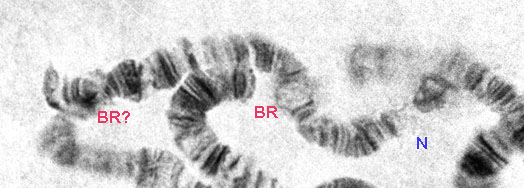Syn: Chironomus fulvipilus Rempel (1939) - Fittkau 1965.
Tendipes (Tendipes) fulvipilus (Rempel) - Townes 1945. Apparently no data in BOLDAdult:
Male: from Townes (1945) and Fittkau (1985)
Wing length 2-2.7 mm. LR 1.65, AR 2.4; VR 1.2. Body slender.
Pale green with head, and thoracic vittae ochreus.
Frontal tubercles small, clypeus very small.
Thoracic setae - acrostichal 10 (8-12); dorsolateral 5 (4-8); prealar 4 (3-4); supraalar 1; scutellar 4 (4-6)
Apex of fore femur, apex and basal half of fore tibia, and tarsi, except the basal part of mid and hind tarsi, brown. Fore tarsi without a beard.
Leg Proportions (Fittkau):
| Fe
| Ti
| Ta1
| Ta2
| Ta3
| Ta4
| Ta5
| LR
| F/T
| BR
|
PI
| 1.41
| 1
| 1.63
| 0.88
| 0.77
| 0.77
| 0.32
| 1.63
| 1.41
| 2.0
|
PII
| 1.15
| 1
| 0.59
| 0.31
| 0.25
| 0.16
| 0.11
| 0.59
| 1.15
|
|
PIII
| 0.93
| 1
| 0.68
| 0.35
| 0.30
| 0.17
| 0.10
| 0.68
| 0.93
|
|
Tergite IX with a group of 10-15 setae. Anal point long and evenly narrow, apically with a small hook; Superior volsella curved, narrow; gonostylus swollen, but sharply narrowing at posterior end.
Female: Similar to male except for usual sexual differences.
Antennal proportions (Fittkau): 140 : 105 : 105 : 90 : 160. AR 0.36; A5/A1 1.14.
Thoracic setae - acrostichal 8.8 (8-10); dorsolateral 11.7 (11-13); prealar 4; supraalar 1; scutellar 5 (4-6).
Leg Proportions (Fittkau):
| Fe
| Ti
| Ta1
| Ta2
| Ta3
| Ta4
| Ta5
| LR
| F/T
| Ta4/Ti
|
PI
| 1.34
| 1
| 1.59
| 0.83
| 0.73
| 0.78
| 0.32
| 1.59
| 1.34
| 0.78
|
PII
| 1.09
| 1
| 0.55
| 0.29
| 0.22
| 0.14
| 0.11
| 0.55
| 1.09
|
|
PIII
| 0.94
| 1
| 0.62
| 0.33
| 0.27
| 0.16
| 0.10
| 0.62
| 0.94
|
|
Anal segments as in Chironomus.Fourth instar larva: Medium sized. Not a typical Chironomus larva - there are two pairs of ventral tubules, but the anterior pair are bifurcate, and where lateral tubules may be developed in Chironomus, there are split feathery bristles. The head capsule is tawny without markings. The dorsal head is basically similar to that of Chironomus, as is the mentum (roughly type IA) although the center tooth and 1st laterals are raised compared to other laterals; 4th laterals not reduced.
Ventromental plates elongated (longer than mentum width) and almost touching in the midline, separated at most by width of center teeth (in Chironomus it is usually by the distance to between the 1st and 2nd laterals).
Pecten epipharyngis with about 11-13 alternating small and large teeth (closest to type D, but not rounded). Premandible (Fig. a, below) of available specimens worn, but comprised of two teeth, the inner very broad, about 7.5 times the width of the quite narrow outer tooth - not as any of the Chironomus-types.
Antenna (Fig. e, below) with five segments. A1 about 3.5 times longer than wide, RO in basal 1/4 to 1/3; AR about 1.17: segment proportions 21 : 7 : 5 : 4 ; 2.
Mandible (Fig. d, below) with 4 darkened inner teeth; seta subdentalis large with a row of small teeth along the inner margin. About 20 taeniae in Pecten mandibularis, but no furrows near base.
Cytology: 4 polytene chromosomes. Chromosome 4 long with a subterminal nucleolus and at least 2 BRs, a large one about 1/3 of arm length from nucleous, and a possible smaller one near the other end of the arm.

Chromosome 4 of G. holoprasinusType locality: Belem, Para, BRAZIL
Found: Florida - St. Augustine; West Palm Beach (Townes 1945)
Maryland - Berlin (Townes 1945)
Texas - Austin, Travis Co.; Sugar Land.
Also found in Central and South America; and in Hawaii (probably by human transport).
[ Return to Index| Go to References ]